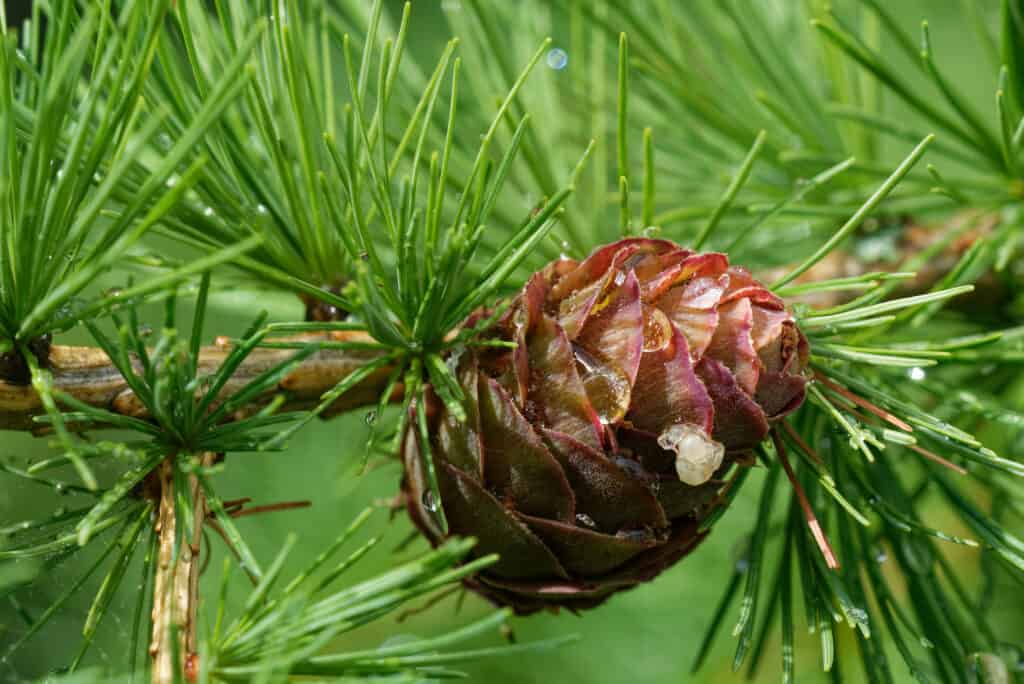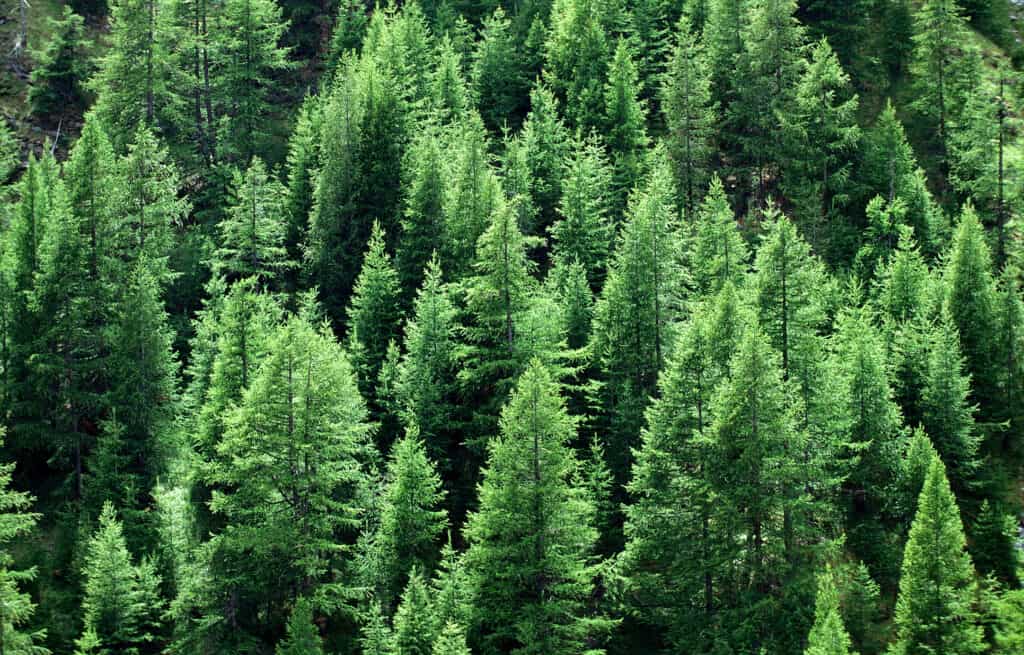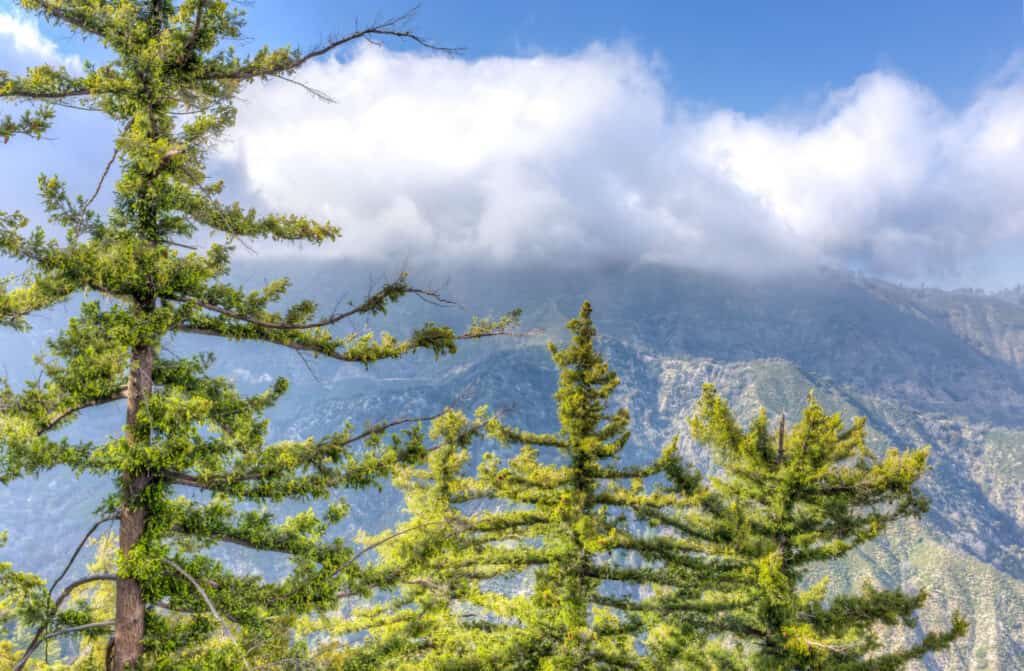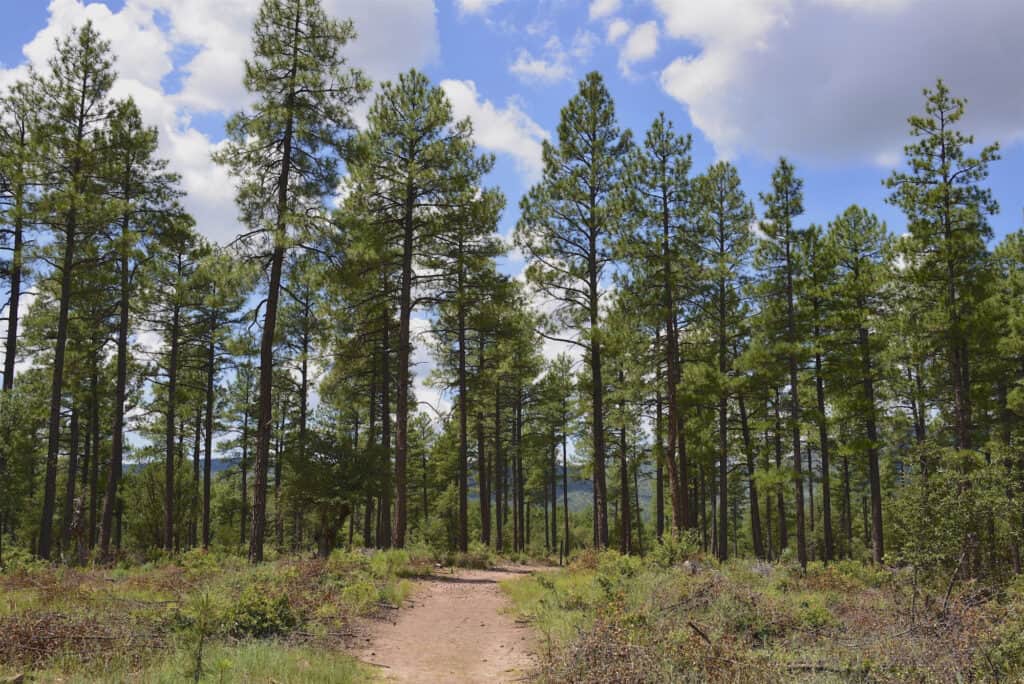Key Points
Larch vs. pine: how do you know which is which? Larch trees (trees in the Larix genus) and pine trees (trees in the Pinus genus) have a lot in common! Both are commonly found in northern parts of the United States, are conifers which produce needles and cones, and can reach staggering heights and old ages.
Because of these, many people have trouble separating larch trees and pine trees. How can you know if the coniferous tree you are looking at is a larch or a pine?
To help you differentiate these two trees, this article will compare and contrasts both trees and highlight similarities and differences.
Before we dive in, here are a few of the characteristics that larches and pines share:
- Both are genera in the Pinaceae family
- Both are conifers, which produce needles and cones
- Both can grow for hundreds of years
- Both are native to cold climates of the northern hemisphere
However, there are also quite a few ways in which larches and pines differ. This article will discuss their histories, classification, differences in appearance, growth and reproduction, and uses. Let’s explore some key differences!
Comparing Larch Vs. Pine
| Characteristic | Larch | Pine |
| Scientific Name | Larix (genus) | Pinus (genus) |
| Family | Pinaceae | Pinaceae |
| Common Name | Larch | Pine |
| Origin | The northern hemisphere, primarily in cool climates in the northern parts of Europe and North America | The northern hemisphere throughout the world |
| Description of Plant | The Larix genus encompasses deciduous conifer trees known as “larches.” In total, the genus includes at least 14 species and hybrids. In North America and Europe, larches typically grow in cooler climates in the northern hemisphere. Their clusters of soft needles change color from green to a vibrant yellow in the fall before dropping to the ground, leaving the tree bare. These trees are fast-growing and can live for hundreds of years. | The Pinus genus encompasses evergreen conifer trees known as “pines.” Relevant authorities accept differing numbers of species of pine trees, with the accepted total number of species typically falling between 105 and 124. Though pine trees grow globally, they are native to cooler climates in the northern hemisphere. Pine trees have thin, green needles which stay the same color throughout the year and do not fall in the autumn season. Pine trees will eventually shed old needles, but this is not an annual process and does not happen all at once like it does for deciduous trees. Pine trees live for hundreds of years, with the oldest pine trees reaching as old as 1,000 years. |
| Size | 40 to 100 feet tall and 20 to 30 feet wide, larger or smaller depending on the species | 15 to 150 feet tall and 2 to 50 feet wide, larger or smaller depending on the species |
| USDA Hardiness Zone(s) | 2-7 | 3-7 |
Larch Vs. Pine: Descriptions
Larch Description

Young ovulate cone of larch tree in the beginning of July.
©iStock.com/HeitiPaves
“Larches” are deciduous trees of the Larix genus, part of the Pinaceae family. Larch trees grow natively in Europe and North America in the northern hemisphere, with three types of tree species (and many different cultivars) native to the North American continent. Larches grow tall, typically reaching 40 to 100 feet high at maturity, with a spread of 20 to 30 feet across. Larches are deciduous conifers famous for having needles which turn a bright golden-yellow color in the autumn.
They then drop their clusters of soft needles in the late autumn or winter, leaving a tree with brown or gray bark bare during the winter. The trees then regrow green tufts of needles in the spring and colorful buds in various colors. These cones will eventually harden and turn brown, falling with the needles in the fall.
Larches live for a very long time. Depending on the larch species, they may grow to be 100 or 200 years old, as in the case of the eastern larch tree. However, other species, such as European larches, have had individual trees growing in the Alps for more than 600 years.
Pine Description
In comparison, pine trees are deciduous evergreen trees of the Pinus genus, which is also part of the Pinaceae family. Pine trees grow all over the world, but they are native to cooler climates of the northern hemisphere. Though experts disagree on the exact number of species, most authorities name between 105 and 124 pine tree species. In contrast to larches, which only have three species growing in North America, approximately 50 species of pine trees are growing on the continent. The height and width of the trees vary immensely depending on the species. The smallest pine tree may be only a few feet tall, while the tallest can reach 150 or 200 feet.
Pine trees are evergreen conifers which have thin, green needles. Unlike larches, which have needles that change color and fall each year, pine tree needles tend to retain their green color throughout the year. Eventually, pine needles do fall, but this can happen after multiple seasons and not fall simultaneously.
While larches live for a long time, their ages are rivaled by the age of pines! Pine trees can easily live hundreds of years, with the oldest reaching as old as 1,000 years. However, a particular species, Pinus longaeva, also known as the Great Basin Bristlecone Pine, is estimated to be the oldest tree. Pinus longaeva can reach as old as 5,000 years!
Larch Vs. Pine: Comparing Two Coniferous Trees
Larch Vs. Pine: Appearance
The appearance of Large Trees

European Larch or Common Larch, larix decidua, Forest near Sisteron in the South East of France
©iStock.com/slowmotiongli
In the northeastern part of the United States, larch trees, specifically the American larch (Larix laricina is a major tree species growing in the wooded landscape. The American larch, also called “tamarack” grows in boggy, swampy areas. In parts of the northeast, it is the only deciduous conifer tree – meaning that it is the only conifer to have needles that change color and fall in autumn. It keeps its small cones, which are between ½ and ¾ of an inch, throughout the winter. The cones produce oval, wing-shaped seeds that get disbursed by the wind. Afterward, cones can stay on the trees for years.
Each spring, the American larch produces tufts of soft green needles about 1 inch long and very dense. These dense clusters of 20 or 40 needles attach to “spur shoots.” The trees gain a light green color, and the needles provide a lackey appearance for the foliage during the summer. The trunk of the American larch tree is between 1 and 2 feet across and has brown or reddish-brown scaly bark.
Over years, larches grow to be between 40 and 100 feet tall with a total spread of 20 or 30. They can be larger or smaller depending on the species, with the American large typically reaching between 40 and 80 feet high.
The appearance of Pine Trees
Pine trees grow across the United States and vary immensely in size and appearance depending on their species. As an evergreen conifer, pines produce needles that grow in clusters. These needles range in size from about 3 to 5 inches long, varying based on the species and region they grow in. Some pine trees have significantly longer needles – sometimes even reaching 9 or 10 inches in length.
Red pine trees grow needles in clusters of two, yellow pine trees grow needles in three, and white pines grow needles in clusters of five. Counting these clusters can allow you to identify a pine tree in contrast to spruce and fir trees, which have individual needles attached to their branches. Compared to the sharp needles of pine trees, larches have dense clusters of many needles that are only 1 inch long and very soft. Pines also produce cones, which vary in size from tiny (less than 1 inch in length) to very large (20 inches long).
Unlike larches, pine tree needles do not turn a vibrant yellow color in the fall. While they may eventually fall off, the needles will just turn brown and gradually fall one by one rather than all at once in autumn. Pines also grow taller than most larch trees. At maturity, they have the potential to be between 15 to 150 feet tall and 2 to 50 feet wide, growing larger or smaller depending on the species.
Larch Vs. Pine: Growing Conditions

Reaching up to 200 feet tall, sugar pines produce the largest cones of any pine tree.
©Ken Wolter/Shutterstock.com
Larch trees grow in various climates and soil conditions but generally prefer cooler temperatures. The American larch typically grows in wet or moist soils rich in organic matter. However, it can grow fairly well in arid soils where the water table is low but will die in drought. The ideal conditions will include moist, well-drained soil, such as that found around bodies of water. The lowest recorded temperatures for an American larch range between -20 and -79 degrees Fahrenheit, with the highest between 85 and 110 degrees Fahrenheit.
Pine trees can be found across a much wider range of geographies and climates. Pine trees grow naturally in the Northern Hemisphere, primarily in the northern temperate zone. However, various pine species grow in wide distribution, with some individual species of pine growing across the North American continent. For example, Pinus ponderosa, the “ponderosa pine,” grows from southern Canada to Mexico, from Nebraska and Oklahoma to California. Many pines grow best in well-drained sandy soil with ready access to nutrients, though a few species can grow well in wetter areas.
Larch Vs. Pine: Significant Species
Major Larch Species
The Larix genus has 14 species and hybrids of larch trees, most of which can be found in Europe. However, in the United States, you will find that states such as Washington, Oregon, Montana, Minnesota, and West Virginia, are cool temperatures for larch trees to flourish. The two most common species in North America are Larix laricina, the American larch, and Larix occidentalis, the western Larch. The American larch is the most common larch tree in North America. They can be found across the northern part of the United States, growing to reach medium heights of up to 60 feet tall. The third North American larch species is Larix lyallii, the subalpine larch.
Other larch species, which are found in Europe and Asia, include:
- European larch (Larix decidua)
- Siberian Larch (Larix sibirica)
- Dahurian Larch (Larix gmelinii)
- Japanese Larch (Larix kaempferi)
- Chinese Larch (Larix potaninii)
- Master’s Larch (Larix mastersiana)
- Himalayan Larch (Larix griffithii)
In addition to these species, several hybrids and cultivars of species, such as the European larch, have been created.
Major Pine Species

Widely distributed, ponderosa pines are some of the tallest pines around.
©SED Travel Photography/Shutterstock.com
Although experts disagree on how to best classify various species in the Pinus genus, one common way is to organize them into three groups: red pines; yellow, also called “hard,” pines; and white, also called “soft” pines. Yellow pines, of which there are many different species, have tough wood and small needle clusters. White pines, of which there are fewer species, have relatively soft wood and more needles in each cluster. Red pine trees have needles which grow in groups of two, yellow pine trees have needles that grow needles in sets of three, and white pines have needles growing in sets of five
Some of the most significant and common species of pines include:
- Sugar pine (Pinus lambertiana): The sugar pine is a white pine species that boasts tall trees with wide trunks and long pine cones. Sugar pines are native to the west coast of the United States, specifically states like California and Oregon.
- Eastern white pine (Pinus strobus): You may know this species because it is sold yearly as a Christmas tree! The Eastern white pine grows from southern Canada to the midwestern and northeastern United States.
- Longleaf pine (Pinus palustris): Longleaf pines are native to the southeastern United States, where it grows in states including Texas, Alabama, and Georgia. They have short, straight branches and long, needle-like leaves that grow in large clusters.
- Loblolly pine (Pinus taeda): Loblolly pines grow in the eastern United States, in states along the Atlantic coastline. This is one of the fastest-growing pine trees in many different soil conditions.
- Western white pine (Pinus monticola): Western white pines are the tallest-growing pine found in western Washington and northwest Oregon. They can reach 200 feet and are recognizable for having large cones in the shape of bananas.
- Ponderosa pine (Pinus ponderosa): Ponderosa pines grow in the southwestern United States and are one of the tallest trees in that region, growing straight and with a large crown.
Larch Vs. Pine: Uses
The American larch and western larch are the dominant larch species in North America and are most often used. Western larch wood is often used as lumber for planks and boards, poles, railroad crossties, and pulp. Larch wood also appears in home interiors for flooring or doors. Larch wood is tough and durable. These qualities make it suitable for boats and outdoor constructions such as gazebos or fences.
Pine is one of the most widely-used and recognized woods. Pine is also commonly used for interiors and in building furniture, flooring, wood paneling, and other home uses. However, pine is also a major material cultivated for sap and resin and sold as firewood. Compared to larch, pine is also incredibly abundant and versatile! It grows across North America and is easy to work with. Because of this, it is used for a wide variety of purposes.
In Summary
This article compares the trees of the Larix genus, larches, with the trees of the Pinus genus, pines. Though both are significant, long-living, coniferous trees, they are set apart from each other by some distinctive features. They differ in where they grow, species diversity, appearance, average size, and growth patterns. Hopefully, this article has equipped you to identify and appreciate both to a greater extent! Each plays a unique role in their habitats and is essential to North America’s biodiversity.
Next Up
- Larch vs. Tamarack
- Discover the 20+ Different Types of Pine Trees
- The Different Types of Evergreen Trees
The photo featured at the top of this post is © Oleksandr Filatov/Shutterstock.com
Sources
- USDA, Available here: https://www.srs.fs.usda.gov/pubs/misc/ag_654/volume_1/pinus/strobus.htm#:~:text=Eastern%20white%20pine%20is%20found,and%20New%20Jersey%3B%20and%20south
- Iowa State University, Available here: https://www.extension.iastate.edu/news/2005/nov/061401.htm#:~:text=Like%20deciduous%20trees%2C%20conifers%20can,pine%20group)%20needles%20per%20cluster.
- Oregon State University, Available here: https://treespnw.forestry.oregonstate.edu/conifer_genera/larch.html
- University of New Hampshire, Available here: https://extension.unh.edu/blog/2018/02/american-larch-stick-mud
- Harvard Arboretum, Available here: https://arboretum.harvard.edu/stories/larch-cones-in-spring/
- USDA, Available here: https://www.srs.fs.usda.gov/pubs/misc/ag_654/volume_1/larix/laricina.htm
- North Carolina Extension, Available here: https://plants.ces.ncsu.edu/plants/larix-decidua/
Thank you for reading! Have some feedback for us? Contact the AZ Animals editorial team.






